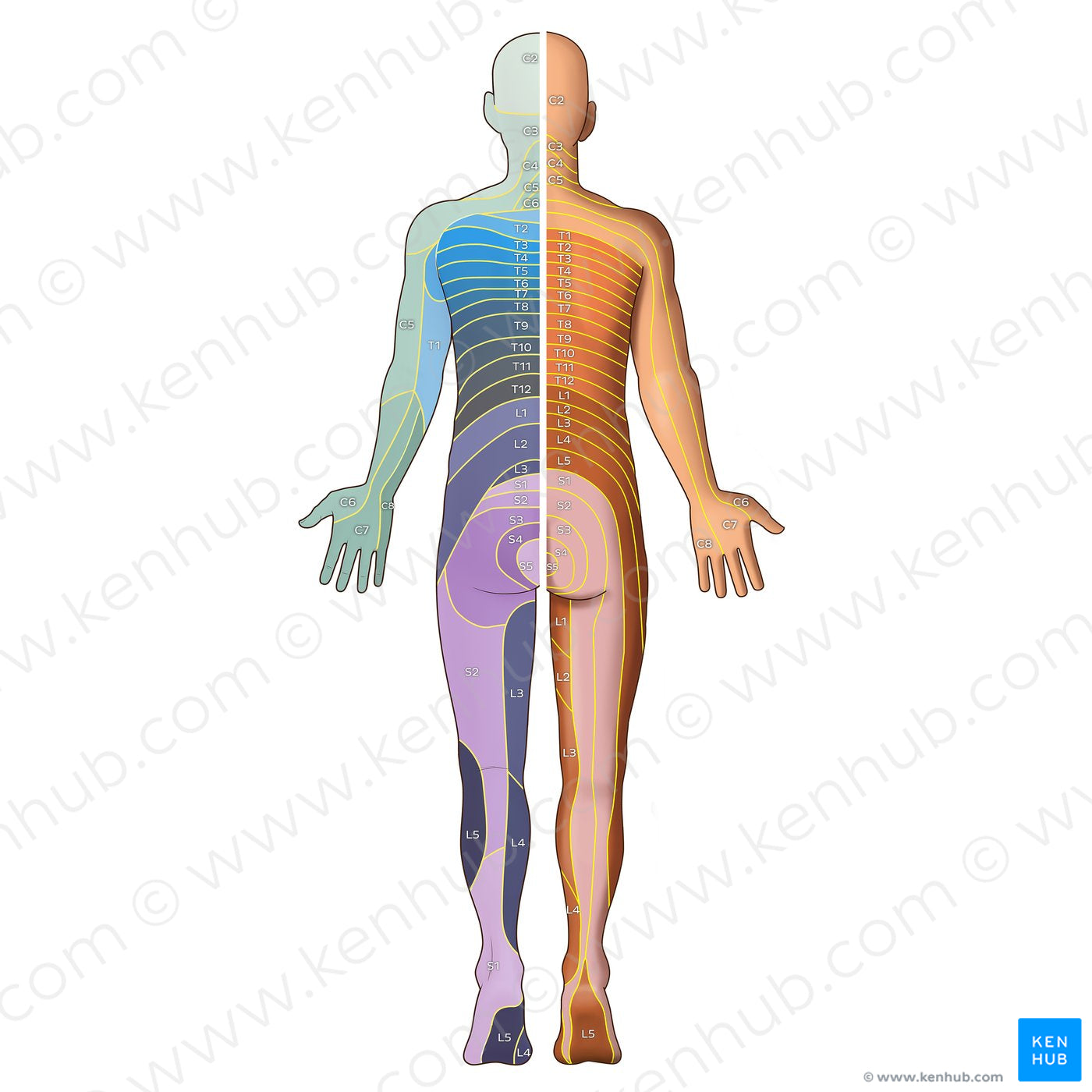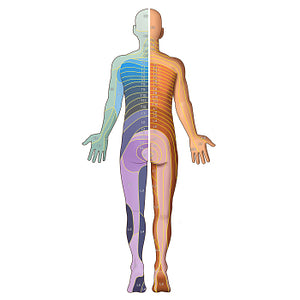Irina Münstermann
Dermatomes: Foerster/Keegan and Garrett map - Posterior (Latin)
Dermatomes: Foerster/Keegan and Garrett map - Posterior (Latin)
The Foerster (right) and Keegan and Garrett (K&G; left), dermatome maps of the dorsal surface of the body placed side by side. The C2 dermatome covers the entirety of the posterior head (caput) on the K&G map, but occupies a higher position in the Foerster map. Similar to the anterior view, a slight variation is seen in the dermatomes of the neck (collum) and shoulder region (regio deltoidea) which is represented as C3 and C4 on the Foerster map, but as C3, C4, C5 and C6 on the K&G map, with C6 extending into the lateral arm (brachium), forearm (antebrachium) and thumb (pollex). In the Foerster map, below C4 and close to the midline are small segments of C5 and C6 that are not continuous with the corresponding dermatomes in the upper limb (membrum superius). The dermatomal pattern exhibits some significant variation between both maps in the upper limb. On the K&G map, dermatomes C6, C7 and C8 cover the posterior upper limb in a sequential manner, with the C6 innervating the lateral part, the C7 the central part and C8 the medial part of the entire upper limb. The dermatomes in the Foerster map follow a segmental pattern, with C5 spreading over the lateral aspect of the arm and elbow region (regio cubitalis), T1 covering the medial aspect of the arm and elbow region, and T2 extending from the upper back (dorsum superius) onto medial aspect of the proximal arm and into the axilla. Dermatomes C6-C8 lie distal to the elbow on the Foerster map, innervating the forearm. Similar to the K&G map, the C6 dermatome covers the lateral side of the forearm, hand (manus) and thumb, C7, the central aspect of the dorsum of hand (dorsum manus) and middle finger (digitus medius manus), while C8 supplies the ulnar side of the forearm, hand and digitus little finger (minimus manus). The dermatomes of the back from T1-T12 have a fairly similar segmental pattern of distribution on both maps. They are nearly horizontal lines and are quite evenly spaced. They roughly cover the skin at the level of the corresponding vertebra. There is significant variation between both dermatome maps in the lower back (dorsum inferius) and lower limb (membrum inferius). The K&G map shows a sequential arrangement of the dermatomes from L1-L5. These dermatomes extend inferolaterally into the lateral aspect of the lower back and lateral aspect of the lower limb, as well as the medial aspect of the lower limb and sole of the foot (planta pedis) after wrapping around the groin (regio inguinalis) and the anterior aspect of the lower limb. On the Foerster map, the lower back and lateral aspect of the gluteal region (regio glutea) are represented by L1 and L2 dermatomes. A small slip of L3 is seen below the L2 dermatome close to the midline. The L3 dermatome, however, mainly covers the medial aspect of the thigh (femur). The L4 dermatome covers the medial aspect of the leg (crus), while the lateral aspect of the knee (genu) and proximal leg represents the L5 dermatome. The gluteal region (regio glutea) in both maps is represented by S1-S5 dermatomes. The main difference is that in the Foerster map, the S1 and S2 dermatomes are segmental and unconnected to the identical dermatomes in the posterior lower limb, while in the K&G map they run in sequence from the gluteal region to the foot (pedis). The S2-S5 dermatomes have a fairly similar spiral and sequential arrangement in the gluteal region of both maps, covering mainly the medial aspect of buttocks (clunes) and regio perinealis.
Normaler Preis
$7.56 USD
Normaler Preis
Verkaufspreis
$7.56 USD
Grundpreis
pro
Verfügbarkeit für Abholungen konnte nicht geladen werden


#2A91DD
#9A6B5C
#6D2A15
#35335A
#F0B58C und #D3AEB1

